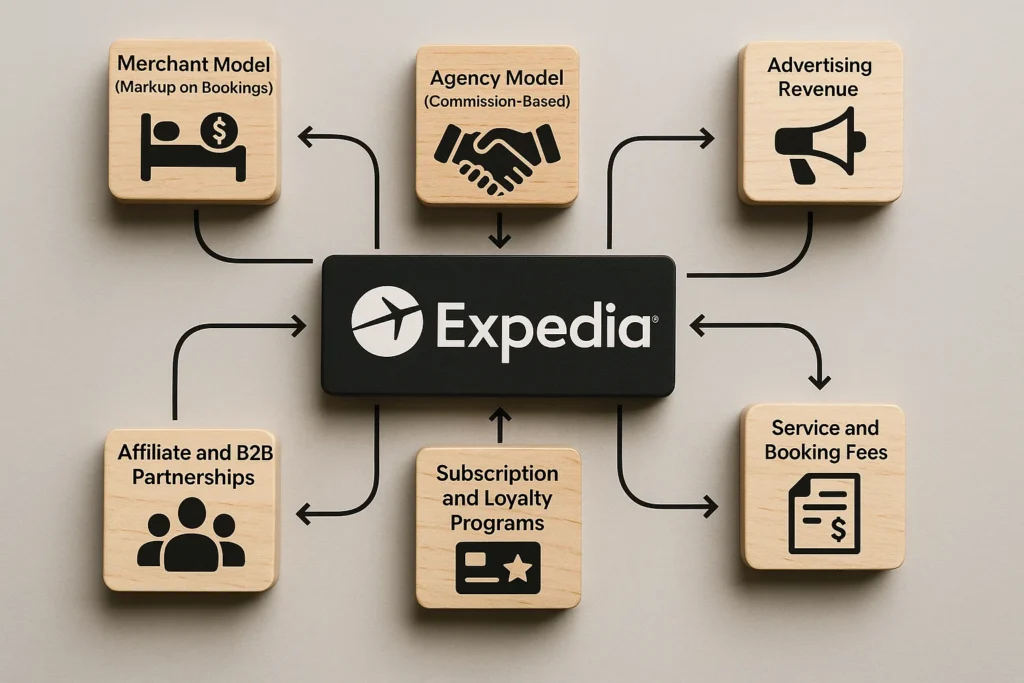Expedia is one of the world’s leading online travel agencies (OTAs), empowering millions to book flights, hotels, car rentals, vacation homes, and entire travel packages through a single interface. Operating under a global portfolio that includes brands like Vrbo, Hotels.com, and Orbitz, Expedia has positioned itself as a powerhouse in the $800+ billion travel industry.
With a massive user base, high brand trust, and global reach, Expedia doesn’t just facilitate bookings — it monetizes nearly every aspect of the travel experience. But how exactly does Expedia Works and make money? And more importantly, can startup founders and digital agencies replicate its monetization model in 2025?
In this blog, we’ll break down Expedia’s revenue streams, highlight why its model remains effective in today’s landscape, and show how you can launch a similar travel platform with a ready-made Expedia clone from Miracuves.
How Expedia Makes Money
Expedia’s revenue model is built on a combination of direct booking margins, commissions, advertising, and value-added services. Here are the major ways Expedia earns its revenue:
- Merchant Model (Markup on Bookings) – Expedia buys hotel room nights in bulk at discounted rates and sells them at a markup.
- Agency Model (Commission-Based) – Acts as an intermediary between hotels or airlines and customers, earning a commission for each completed booking.
- Advertising Revenue (Expedia Media Solutions) – Travel brands and destinations pay to advertise across Expedia’s network of websites.
- Service and Booking Fees – Adds service charges on certain bookings, especially flights, car rentals, or vacation packages.
- Subscription and Loyalty Programs – Earns from traveler loyalty programs like One Key and partner loyalty integrations.
- Affiliate and B2B Partnerships – Offers white-label travel booking engines to partners and earns through affiliate models.

This hybrid model allows Expedia to balance high-margin direct bookings with scalable commission-based listings, while also unlocking recurring revenue through advertising and partnerships.
Expedia turned online bookings into a travel empire by blending commissions, ads, and partnerships—explore the Expedia business model to see how it works.
Detailed Breakdown of Revenue Channels
Merchant Model (Markup on Bookings)
Expedia purchases inventory — especially hotel rooms — at wholesale prices and sells them to consumers at a markup. This gives Expedia control over margins and the ability to offer bundled discounts.
- Who Pays? End users pay Expedia directly.
- Why It Scales? Higher margins and control over pricing and bundling.
Agency Model (Commission-Based)
In this model, Expedia acts as a facilitator. The traveler pays the hotel or airline directly, and Expedia takes a commission (typically 10%–25%) on each successful booking.
- Who Pays? Hotels, airlines, vacation rental owners.
- Why It Scales? No inventory or operational overhead for Expedia.
Advertising Revenue (Expedia Media Solutions)
Expedia operates one of the largest travel ad networks. Hotels, tourism boards, and airlines pay to run display ads, native placements, or retargeting campaigns across Expedia’s portfolio.
- Who Pays? Travel brands, destination marketers, global advertisers.
- Why It Scales? High traffic volume and performance-based campaigns.
Service and Booking Fees
Expedia adds booking fees on select services like car rentals, flights, and vacation packages. These are typically non-refundable and vary by region or category.
- Who Pays? Travelers at checkout.
- Why It Scales? Generates margin per transaction and supports operational costs.
Subscription and Loyalty Programs
Expedia’s loyalty program One Key offers exclusive savings and perks. The model encourages repeat bookings while enabling upsell of premium services and early access deals.
- Who Pays? Frequent travelers and subscribers.
- Why It Scales? Builds customer retention and recurring revenue.
Affiliate and B2B Partnerships
Expedia provides white-label booking engines and APIs to thousands of travel sites, banks, and corporate partners. Through Expedia Partner Solutions (EPS), they earn affiliate income and B2B commissions.
- Who Pays? Affiliates and corporate partners.
- Why It Scales? Allows Expedia to monetize travel searches far beyond its own platforms.
From flight bookings to hotel deals, Expedia makes travel seamless—explore the Expedia features every travel app should have.
Why This Revenue Model Works in 2025
Expedia’s multi-pronged revenue strategy continues to thrive in 2025, thanks to evolving travel trends, advanced tech integrations, and increased digital demand.
Global Travel Surge Post-Pandemic
International and domestic travel demand has surged, especially for flexible bookings, staycations, and remote-work getaways. Expedia’s diversified inventory and dynamic pricing let it capture value across all categories — from budget to luxury.
AI-Powered Personalization and Pricing
Expedia uses machine learning and AI to personalize results, optimize pricing, and recommend add-ons — increasing average order value (AOV). This tech-driven upsell approach strengthens every revenue stream, from hotels to car rentals.
Rise of Experience-Based Travel
Today’s travelers seek more than flights and hotels — they want activities, packages, and localized experiences. Expedia’s ability to monetize activities and bundles aligns perfectly with this behavior shift.
Advertising as a Core Profit Engine
As travel brands compete for visibility, Expedia’s ad network (Expedia Media Solutions) has become a key revenue driver. High traffic + intent-rich audience = excellent ROI for advertisers and a profitable non-transactional stream for Expedia.
Subscription Loyalty at Scale
With One Key unifying loyalty across Expedia, Hotels.com, and Vrbo, the brand boosts repeat usage while generating subscription-based perks — a recurring income trend gaining traction across tech and travel.
Expedia mastered the art of blending storytelling with smart targeting—explore the Expedia app marketing strategy that keeps travelers clicking.
Can Startups Replicate Expedia’s Revenue Model?
Yes — but doing it from scratch is no small feat.
Expedia’s model thrives on scale, real-time integrations, global inventory, and advanced personalization. For startups, developing such a feature-rich travel ecosystem requires enormous time, tech resources, API partnerships, and UX refinement — not to mention regulatory and payment challenges across borders.
That’s why many entrepreneurs and digital agencies turn to Miracuves.
With our Expedia Clone, startups can tap into a proven, revenue-ready platform that mirrors Expedia’s most successful features — all while retaining full customization control.
Here’s what the Miracuves Expedia Clone offers:
- Merchant + Agency booking models baked in
- Commission and convenience fee engines ready for activation
- Integrated ad modules for hotels, experiences, and travel brands
- Multi-vendor admin dashboards and traveler-side UX
- Loyalty and wallet systems to boost retention and monetization
- B2B and affiliate-ready modules to expand reach beyond direct customers
Time-to-market matters. With Miracuves, startups can skip the complexity and launch a full-scale OTA platform that earns from day one — while keeping room to grow globally.
The Expedia Clone by Miracuves is priced at $2,899, offering a powerful white-label travel marketplace that allows users to book flights, hotels, and experiences — ready to go live within 3 days.
Launching your own travel platform starts with the clone scripts for 2025, choosing the right development company, seeing why startups prefer our clone, and following the developer guide in JavaScript & PHP to build it right.
Conclusion
Expedia’s revenue model is a shining example of how to build a scalable, multi-channel business in the travel tech industry. By blending the merchant and agency models with strong advertising income, loyalty perks, and B2B partnerships, Expedia has created a monetization engine that works across borders and platforms.
In 2025, this model is more relevant than ever — thanks to digital-first travelers, AI-enhanced pricing, and the demand for end-to-end booking convenience.
The best part? You don’t need to build it all from scratch.
With Miracuves’ Expedia Clone, startups and agencies can launch their own travel platform with all the monetization levers built-in — from commissions and markups to advertising and subscriptions.
FAQs
How does Expedia generate revenue?
Expedia earns through a hybrid of merchant markups, commissions via the agency model, advertising sales, booking fees, loyalty subscriptions, and B2B partnerships with travel affiliates and brands.
Is Expedia profitable in 2025?
While profitability can fluctuate due to seasonality and investments, Expedia continues to strengthen its margins through high-margin services, ad revenue, and increased post-pandemic travel demand.
What are the main income sources for Expedia?
Expedia’s major income sources include hotel and flight markups (merchant model), commissions (agency model), advertising through Expedia Media Solutions, loyalty programs like One Key, and affiliate sales.
Can startups use the same revenue model as Expedia?
Yes, startups can replicate Expedia’s revenue streams, but building it from scratch is complex. A ready-made Expedia clone from Miracuves offers a faster, more cost-effective way to implement the same monetization tactics.
Does Miracuves offer an Expedia clone with monetization features?
Yes, Miracuves provides a fully-loaded Expedia clone that includes commission settings, advertising modules, subscription plans, affiliate integrations, and real-time booking architecture — all tailored for scalable revenue.








